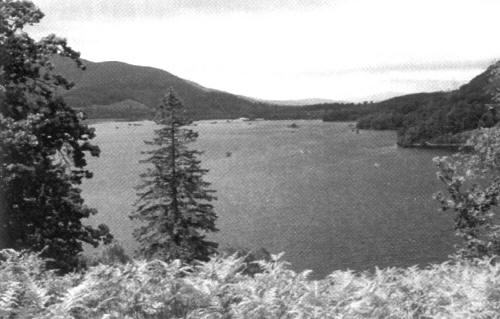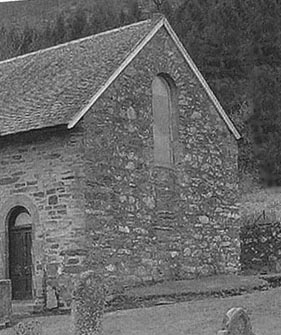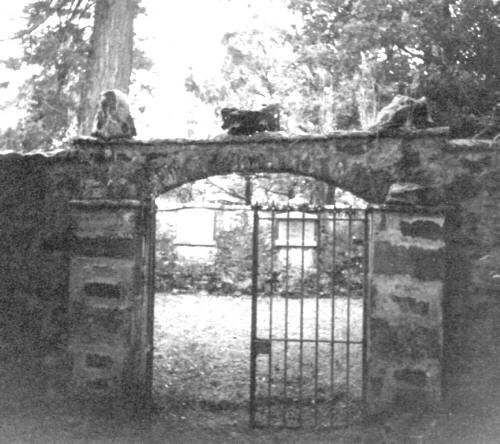|
The burial places of the early chiefs of Clan Donnachaidh are shrouded in
uncertainty. Much of what we ‘know’ is based on legend or oral history and
oral histories are notoriously unreliable. Nevertheless, oral histories
tell us of what was once believed to be true and about beliefs that may
have guided action. They may also, in the absence of other data, be a
starting point for research. It is therefore important to record oral
traditions as well as historical data lest they be lost to us.
Our first chief Duncan
Reamhair (circa 1275-1355), legend suggests, was buried in the now
deconsecrated and unused parish church at Dull near Weem in Strathtay. The
History and Martial Achievements of the Robertsons of Strowan, published
in 1797, declares that Duncan Reamhair was ‘buried at Dull in Athole where
his grave is still to be seen and much admired for its extraordinary
length’. Duncan Reamhair was reputedly a man of great stature. Consistent
with this account is an oral tradition prevalent in Atholl as recently as
the 1960s that held that his grave lies just outside the eastern end of
the present church. Duncan Reamhair, being an important person, would have
been buried in, rather than outside, the church but, according to this
tale, the apse of the church was removed during one of its many
remodellings; as a result his grave is now to be found outside the church
(papers of Langton Robertson of Struan, 23rd Chief, 1969). This is not an
improbable tale. The present church is believed to have been built on the
site of earlier ecclesiastical foundations dating back to an
eighth-century abbey founded in memory of St Adamnan. The abbots of
Dunkeld were also the abbots of Dull and, according to Skene, Duncan
Reamhair was a direct descendant of the abbots of Dunkeld and Dull and
proprietor of the abbey lands. So it is possible that he was buried here.

Burial View
Some time later -
possibly in the fifteenth century - Struan church at the confluence of the
Garry and the Errochty, became the burial place of the chiefs. There is
documentary evidence of the existence of a parish church in Struan as far
back as the thirteenth century. The present church was built in 1828
alongside a stone church of greater size built some time before 1600 (the
late Donald Cameron, minister of Blair Atholl and Struan, Clan
Donnachaidh Annual 1955).
The plan of lairs in
Struan churchyard shows that two lairs located a few feet to the right of
the altar end of the present church are reserved for Robertsons of Struan.
The first would have been within, and at the sanctuary end of, the old
church. The second lair is adjacent to the first but would have been just
outside the old church. It is because these lairs are believed to be the
burial place of the early chiefs of the Clan that the Chief and his family
have traditionally stood here after the service in the Kirk that brings
the Clan's annual gatherings to a close while the Chief’s piper plays a
Lament in memory of our Chiefs and of all our departed forbears.
The Poet Chief,
Alexander Robertson of Struan (the 13th chief, circa 1670-1749) is the
only chief of whose burial at Struan I have so far been able to find a
documentary record. He was apparently buried with great ceremony in the
family vault beneath the aisle of the old church. James Robertson in his
history of the Chiefs of Clan Donnachaidh 1275-1749 and the Highlanders at
Bannockburn (published in 1929) says that ‘his funeral was the largest
that has ever been seen in Rannoch, having been attended by two thousand
persons of all ranks’. Struan’s coffin was apparently borne by a
carrying-party all the way from Carie, where he died, to Struan. (This
account was written nearly 200 years after the Poet Chief’s death and is
not sourced. Subsequent accounts that I have come across are derived from
it)
In the centuries that
followed the Poet Chief’s burial at Struan a ‘foreign field’ was to be the
final resting place of three of the chiefs. A secluded walled enclosure on
the Dunalastair Estate by the Tummel became the burial place of at least
four chiefs. The burial place of two chiefs remains shrouded in
uncertainty. In 1983, with the interment of the ashes of Langton, the
twenty-third chief (Gilbert’s father), Struan churchyard once again became
the final resting-place of a Donnachaidh chief.
The Poet Chief’s
successor, Duncan (the fourteenth chief) was, like him, an active
supporter of the Jacobite cause and died in exile in France circa 1780. He
is reputedly buried at Givet in the Ardennes.
The fifteenth chief,
Duncan’s son Lt-Col Alexander Robertson, died in December 1822 and was
buried on his Dunalastair Estate on January 2, 1823. By this time the
‘old’ Struan church was derelict and the family vault beneath its aisle
had been sealed. This circumstance may have led to the fifteenth chief’s
choice of Dunalastair as his final resting place and to the establishment
there of what is now known as the Chiefs’ Burial Ground. His funeral is
recorded in The Perthshire Courier of January 10, 1823. Their
correspondent wrote:
‘Wednesday the 1st curt, being the day appointed for removing the body of
Colonel Robertson from Rannoch Barracks [where he died] to Mount
Alexander, about 17 miles distant, nearly 400 persons, chiefly of the name
of Robertson, assembled in the morning to pay the last services to him
whom in life they had so much honoured and respected. As soon as the
coffin, containing the body of the deceased, was placed on the lawn in
front of the Barracks, all the company uncovered, and in a solemn and
orderly manner marched round the body two a-breast, after which an elderly
man advanced forward to the head of the coffin, and delivered a long
oration in Gaelic, enumerating the deeds and virtues which adorned the
deceased chieftain, both as a friend and benefactor. When this was
concluded, the company again marched round the coffin in the same order as
before, when another elderly man delivered an oration similar to the
first. The corpse was then conveyed to the hearse, which set out for Mount
Alexander, followed by all the company, and arrived there in the evening
and next day the body was consigned to the grave, in a piece of ground
marked out by the chieftain for that purpose, a short time previous to his
decease’.
From this last sentence, it is perhaps reasonable to infer that Col
Alexander was the first chief to be buried on the Dunalastair Estate.

Dull Kirk
The sixteenth chief,
Captain Alexander Robertson (1745-1830), and the seventeenth chief,
Major-General George Duncan Robertson (1766-1842), Langton (the 23rd
chief) was told by a local savant in the 1960s, were buried in Struan
churchyard. This tale is plausible. When Captain Alexander died in 1830,
the church at Struan had been rebuilt and it is reasonable to suppose that
he and his successor, Major-General George Duncan (who died in 1842), were
buried in the Struan lair that lay just outside the walls of the old
church. However, I have not been able to find any documentary evidence of
their burials. And it is also possible that they were buried at
Dunalastair thus establishing a tradition that the eighteenth chief was to
perpetuate.
When the Dunalastair
Estate was sold in the 1850s, the eighteenth chief, Lt George Duncan
Robertson (1816-64) reserved for himself and ‘his heirs and successors in
the remainder of the said Barony of Strowan the right and privilege of
interment in the family Burying Ground for the members of his family of
Strowan with the necessary access at all reasonable and proper times
thereto for the purpose of interment or for visiting the same or for the
repairing the walls thereof’ (from the Notarial Instrument of Struan propy,
1865). The eighteenth chief was himself buried there in 1864. An obituary
notice in The Scotsman (April 18, 1864) records that he was ‘carried
shoulder-high by his men and the stout shepherds of Rannoch and lowered
into his rest by his brother officers of the Athole Guard’.
The nineteenth and
twentieth chiefs, Alexander Gilbert (1806-1884) and Alasdair Stewart
(1863-910) were also buried at Dunalastair. Alexander Gilbert’s burial
there is recorded in the Perthshire Constitutional of October 22, 1884. Of
Alasdair Stewart’s funeral, the Perthshire Advertiser (June 1, 1910)
records:
‘After passing through the grounds of Dunalastair, the coffin covered with
beautiful white flowers, was carried from the avenue to the burial ground
by relays of the Rannoch men, most of them wearing the kilt, and by
representatives of the Clan Donnachaidh Society preceded by pipers Thomas
M’lauchlan, Auchleeks, and John Stewart, 1st Scottish Horse, playing The
Flowers o' the Forest and Struan’s Lament.’
A
colourful and detailed description of his funeral by the then Secretary of
the Clan Society, Sarah Robertson Matheson, later appeared in the Celtic
Monthly (September 1910) and was reprinted in the Centenary Clan Annual of
1993.
Alasdair Stewart died
without issue and so was succeeded by the great-grandsons of the sixteenth
chief, Robert Joseph Stewart (1865-1926) and George Duncan (1867-1949).
Their grandfather (the youngest son of the sixteenth chief) was among
those nineteenth-century Scottish colonial pioneers who, seeking to escape
the economic dislocations of the Highlands, helped to people, defend and
build the British Empire and Commonwealth. He settled in Jamaica in the
1820s and his son and grandsons lived, worked and died there. Robert
Joseph Stewart died, unmarried in 1926 and is buried in the parish of
Clarendon. His brother, George Duncan, died in 1949 and is buried in the
parish church of St Andrew in Kingston.
Langton (George
Duncan’s son and Gilbert’s father) also lived, worked and died in Jamaica.
He visited the clan lands twice, in 1970 and in 1975. He chose Struan as
his final resting place. His ashes were interred at the site of the first
Struan lair in Struan churchyard in a moving ceremony in October 1983. A
memorial stone bears the simple inscription for which he had asked and
which eloquently signifies his deep attachment to the country of his
forbears and the people amongst whom he was the Chief. It reads:

Here were laid the ashes of
LANGTON ROBERTSON OF STRUAN
Chief of Clan Donnachaidh.
Born June 4, 1898.
Died August 23, 1983.
The Chief who came home from a distant place.
All three burial places of
the chiefs in Scotland have been designated places of architectural and
historical importance. Dull and Struan were given B listed status in 1971.
The Chiefs’ Burial Ground at Dunalastair was given C/S listed status in
1981 as having local historical significance, and merit as a structure
pre-dating 1840, surviving in a substantially unaltered state (Historic
Scotland: letter dated December 16, 2003). The Clan Society has in some
measure been involved in cherishing all three. Members of the Society are
currently involved in an archaeological dig at Dull (reported on elsewhere
in this Annual) which it is hoped will shed some light on the early
Christian and medieval periods of the church. Struan church is cherished
as the place where generations of clansmen and women have worshipped and
are buried as well as the burial place of our early chiefs. When the
church was being refurbished in the 1950s, the Clan Society presented it
with a baptismal font and a carved panel of the Evangelists. The Chiefs’
Burial Ground at Dunalastair was for decades maintained by the Rannoch
and Highland branch supported by donations from the chief’s family and the
London and Southern Counties branch. At the beginning of the 1990s it was
purchased for the Clan Society from the present
owner of the Dunalastair Estate by US members of the Society and a trust
established for its maintenance in perpetuity. Memorial tablets to
two of the chiefs buried there, George Duncan and Alasdair Stewart (the
latter placed by Langton in 1968) have been in place for some time.
Memorial tablets to the fifteenth and nineteenth chiefs are now planned.
Both Struan and
Dunalastair have been vividly described in our annals. Of Struan church,
it has been said: ‘On that green knoll at the confluence of the Garry and
Errochty there is a sense of peace and the stillness that speaks to the
hearing ear. It is a simple, little church, quiet in its surroundings,
suited to the environment and blending with one of the beautiful scenes of
Scotland.’ (the late Rev Donald Cameron, M.A. Minister of Blair Atholl and
Struan in a sermon at a clan service).
And of the Chiefs’ Burial Ground at Dunalastair, it has been written:
‘A
more exquisite place is not in all the Perthshire Highlands - of which it
is the very heart - a little wooded knoll near Dunalastair within whose
lofty pines the shadow of death gently and for ever broods, even at noon,
over the few graves of the lords of the clan and their kin, at its foot
the wild Rannoch, now asleep, now chafing with the rocks, and beyond the
noble Schiehallion, crowned as it was on that day [the day of the burial
of the eighteenth chief] with snow and raked with its own pathetic
shroud-like mists.’ (from the Obituary Notice of the 18th Chief, George
Duncan, which appeared in The Scotsman, April 18, 1864).

Faith Robertson Elliot
I would like to hear from
readers who may have further information about the burial places of the
chiefs of the Clan and in particular of the sixteenth and seventeenth
chiefs, Alexander Robertson and Major-General George Duncan Robertson. I
may be contacted through the Clan Society or by e-mail
bobandfaithelliot@larriston.fsnet.co.uk
I would like to thank
Patricia Kerr, former curator of the Clan Donnachaidh Museum of drawing my
attention to a letter in the Blair Castle archives that first revealed the
burial at Dunalastair of the fifteenth chief.
Jeremy Duncan of the A.K.
Bell Library, Perth, and the National Library of Scotland, Edinburgh, for
their help in tracing newspaper accounts of the funerals of the nineteenth
century chiefs.
Historic Scotland for
information on the listed status of the burial places. |

